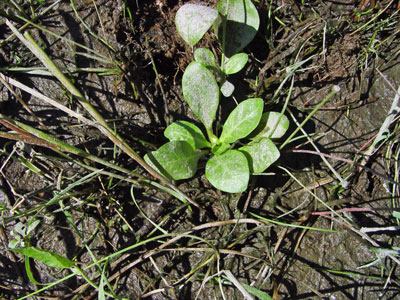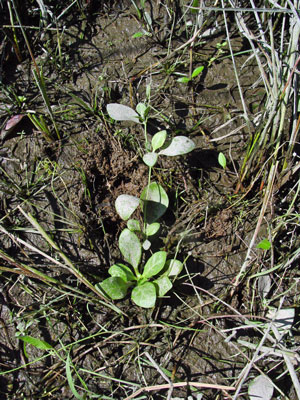DACF Home → Bureaus & Programs → Maine Natural Areas Program → Communities, Plants, and Animals → Rare Plants → Samolus valerandi

Samolus valerandi L. ssp. parviflorus(Raf.) Hultén
Water Pimpernel
- State Rank: S3
- Global Rank: G5
- State Status: Special Concern
Habitat: Shallow water and wet soils. [Tidal wetland (non-forested, wetland)]
Range: New Brunswick, south to Florida, west to Mexico and California, north to Alaska.
Aids to Identification: Water pimpernel has a basal rosette of oval, light-veined leaves at all seasons. In summer, an elongate branched raceme (10-50 cm), bearing small, alternate leaves and tiny white bell-shaped flowers (2-3 mm wide), arises from the rosette. The stamens occur opposite the corolla lobes, in contrast to the usual arrangement of stamens alternating with the corolla lobes.

Ecological characteristics: Though to the south water pimpernel may grow in brackish sites and inland on muddy banks of fresh streams, in Maine it seems to be restricted to the upper edge of the intertidal zone of estuarine rivers where the water that reaches it briefly at high tide is strictly fresh. It most often grows on rocky shores or cobbly beaches in the shade of overhanging trees, herbaceous vegetation, or ledges. It can be variable in size but always seems to flower profusely over an extended period.
Phenology: Flowers July - October. Perennial, the basal rosette of leaves persisting through the winter.
Family: Theophrastaceae
Synonyms: Samolus floribundus Kunth; Samolus parviflorus Raf.
Known Distribution in Maine: This rare plant has been documented from a total of 13 town(s) in the following county(ies): Penobscot, Sagadahoc, Waldo, York.
Reason(s) for rarity: Habitat naturally scarce; near northern limit of range.
Conservation considerations: Prevent degradation of estuary habitat from adjacent land uses.